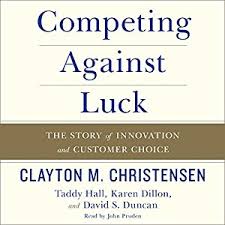Clayton Christensen: Competing Against Luck [Case Studies]
 Competing Against Luck is the rather curious title of a new book by the eminent innovation guru, Clayton Christensen, ably assisted by three acolytes, Hall, Dillon, and Duncan. It is an important work which makes some big claims. The authors expound on and develop the theory of Jobs-to-be-Done (JTBD) and they assert that for the first time this gives a roadmap for where and how a company should innovate to undermine established leaders or create new markets. The Jobs-to-be-Done idea has been around for a while but this book puts it into an academic framework, gives many examples of how it has been used and advises methods for how to harness this approach.
Competing Against Luck is the rather curious title of a new book by the eminent innovation guru, Clayton Christensen, ably assisted by three acolytes, Hall, Dillon, and Duncan. It is an important work which makes some big claims. The authors expound on and develop the theory of Jobs-to-be-Done (JTBD) and they assert that for the first time this gives a roadmap for where and how a company should innovate to undermine established leaders or create new markets. The Jobs-to-be-Done idea has been around for a while but this book puts it into an academic framework, gives many examples of how it has been used and advises methods for how to harness this approach.
The authors argue that managers focus mainly on product features, customer characteristics, trends, market data and competitive offerings. They should instead focus on the job that the customer ‘hires’ their product or service to do. A ‘job’ is defined as the progress that a person is trying to make in a particular circumstance. For example, when a smoker takes a smoke break they are superficially meeting a need for nicotine. But the smoker is also hiring the cigarette to calm and relax him. And in a work environment, he will go outside for some social contact and gossip with fellow smokers. So in some ways, Facebook competes with smoking as Facebook is hired for a similar job to be done!
One of the most valuable parts of the book is the chapter on Job Hunting – how do you find the jobs that customers want done? They recommend five methods:
- Close to home – look for your own problems and pain points for jobs that you and other people need.
- Competing with nothing – you can learn more from the people who are not hiring any product or service than from those who are. There might be a huge opportunity for people who find all current offerings inconvenient in some way.
- Workarounds – Try to spot consumers who are struggling to resolve a job to be done by cobbling together a workaround or compensating behaviour.
- Look for things that people don’t want to do. CVS pharmacy stores were founded to give instant advice and meet the medication needs of people who do not want to wait in line to see a doctor.
- Unusual uses. Observe how your customers use your products – especially in ways that you had never envisioned.
Another important insight is that hiring a new product usually involves firing an old one. Managers focus on the great new features in their product but neglect to consider the emotional and practical inconveniences of moving away from the client’s current solution.
Uncovering a job to be done is just the start. New products succeed not because of the features they offer but because of the experiences they enable. The book goes on to show how you can develop functional, emotional and social dimensions of the progress that the customer wants.
There are many well-documented case studies in the book including American Girl dolls, IKEA furniture, Kimberley-Clark incontinence pads, Medtronic pacemakers, P&G diapers and Intuit Quickbooks. Sometimes the examples seem a little forced to fit the theory but they are valuable none the less.
The book is written in a very solid, academic and workman-like style so it is not an exciting read. If you are familiar with Jobs-to-be-Done theory then you may be disappointed that the book contains no major new insights or revelations. Nevertheless, this volume covers the concept thoroughly and is an important addition to the bookshelf of any innovation advisor or practitioner.
image credit: harperbusiness.com

Wait! Before you go…
Choose how you want the latest innovation content delivered to you:
- Daily — RSS Feed — Email — Twitter — Facebook — Linkedin Today
- Weekly — Email Newsletter — Free Magazine — Linkedin Group
 Paul Sloane writes, speaks and leads workshops on creativity, innovation, and leadership. He is the author of The Innovative Leader and editor of A Guide to Open Innovation and Crowdsourcing, published both published by Kogan-Page. Follow him @PaulSloane
Paul Sloane writes, speaks and leads workshops on creativity, innovation, and leadership. He is the author of The Innovative Leader and editor of A Guide to Open Innovation and Crowdsourcing, published both published by Kogan-Page. Follow him @PaulSloane
NEVER MISS ANOTHER NEWSLETTER!
LATEST BLOGS
Four ways you can ensure employees take accountability for their work
One of the most important driving factors for any successful business is a high-performing team. Having people working for you…
Read MoreWhat is digital upskilling and why is it important?
Photo by Annie Spratt on Unsplash In a world of business that never stands…
Read More

